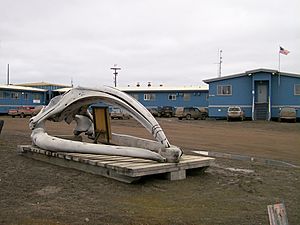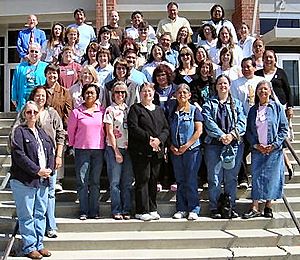Tribal colleges and universities facts for kids
Tribal colleges and universities (often called TCUs) are special schools in the United States. They are like other colleges but are run by American Indian tribes. These schools help Native American students get a good education while also learning about their own cultures and traditions.
The first tribal college was started by the Navajo Nation in 1968. Since then, many more have opened. As of 2018, there are 32 fully approved TCUs in the United States. In 1994, the U.S. Congress officially recognized them as land-grant colleges, which means they get special support.
Some other schools, called Native American-Serving Nontribal Institutions (NASNTIs), also help many Native American students. These are not run by tribes but have a large number of Native American students who need financial help.
Contents
How Tribal Colleges Started
The idea for tribal colleges grew from a movement in the 1960s where Native American tribes wanted more control over their own lives and education. They wanted to teach their children about their culture and help them gain skills for jobs. These colleges are usually built on or near Indian reservations. They offer college degrees and job training to both Native American and non-Native students in many rural areas.
The very first tribal college was Navajo Community College, which is now called Diné College. It opened in Tsaile, Arizona, in 1968. It became officially recognized as a college in 1979. At first, there were different ideas about how these colleges should be. Some thought they should be just like other colleges, while others wanted them to focus more on tribal culture.
Over time, most tribal colleges have created classes that include their Native culture and traditions. These schools often face challenges like finding enough money and keeping teachers and students. However, many tribes have used money from things like casino gambling to help build their schools.
More and more students have joined tribal colleges. In 1982, about 2,100 students were enrolled. By 2003, this number grew to 30,000! This also happened as many American Indians moved back to their reservations. Since the 1990s, focusing on education that fits Native American cultures has also helped more students enroll.
Most tribal colleges offer two-year degrees. However, six of them offer four-year degrees, and three even have master's degree programs. Some colleges, like the College of the Menominee Nation, have agreements with state universities. This means students who finish a two-year program at a tribal college can easily transfer to a state university.
In 2011, President Barack Obama signed an order to help improve education for American Indian and Alaska Native students. This order aimed to help more students finish school, close the learning gap, and keep Native languages alive.
As of 2013, Montana is the only state where every Indian reservation has its own fully recognized tribal college. The University of Montana was the first to make it easy for students to transfer from all tribal colleges. Montana also has a law that requires public schools to teach American Indian history and culture.
Research at Tribal Colleges
Supporting Teachers at TCUs
In 2017, some researchers studied what teachers at tribal colleges needed. They found that teachers were most worried about their workload and low pay. Tribal colleges often get less money because they are on reservations and don't get local taxes. This can make it hard to keep experienced teachers.
The study also found that teachers who were not Native American had more trouble learning about Native American culture. The researchers suggested that tribal colleges should help these teachers learn more about the culture to better support their students.
How Mentors Help Students
Research at Chief Dull Knife College showed that Native American students really benefit from special one-on-one help and support from mentors. Students who worked on research projects with a mentor felt much more confident about themselves and their future.
After being mentored, students believed they could use science in their education and careers. They did well in advanced science classes, even if they had struggled before. This mentorship helped students see their strengths and imagine new futures for themselves.
Keeping Native Languages Alive
Many tribal colleges offer classes in Native languages. They are also starting to teach these languages to younger children. People involved in these programs are seeing small successes, like hearing more greetings in Native languages on campus. Some programs connect children with elders and help parents learn the language too. Tribal colleges are playing a big part in saving these important languages.
List of Institutions
Working Together: AIHEC
In 1973, the first six tribal colleges created the American Indian Higher Education Consortium (AIHEC). This group helps tribal colleges support each other and work with the government on education policies. Today, AIHEC includes 37 tribal colleges and universities.
Each of these schools was started by its own tribe to offer college education that is local, culturally based, and supportive. Through AIHEC, the colleges continue to work together. They get help, connect with other schools and government groups, and plan new programs. AIHEC helps lead and shape policies for Native American higher education.
Special Programs at TCUs
One special program is Tribal Earth Science & Technology Education (TRESTE). This program is funded by NASA. It helps nine tribal colleges and other universities teach about Earth science and mapping. The goal is to inspire students to work in science and engineering.
Another important program is the Tribal College Librarians Institute (TCLI), which started in 1989. Librarians from Montana State University Library began this workshop to help librarians at tribal colleges. Over time, it grew to include librarians from all tribal colleges in the United States. TCLI helps librarians learn new skills and connect with each other. It is often held in Bozeman, Montana, but has also been in other cities.
Scholarships for Students
The American Indian College Fund helps students at tribal colleges and universities pay for their education. It provides scholarships to over 4,000 American Indian students each year. This fund is very important because in 2008, fewer Native Americans had college degrees compared to the national average. The fund has given out many scholarships and millions of dollars to support Native American communities.
Other scholarships are also available, sometimes for specific tribes or areas. For example, there are scholarships for Alaskan Natives. The Native American Journalists Association (NAJA) also offers scholarships and internships for Native American students who want to study journalism.
Interestingly, University College Cork in Ireland offers scholarships to members of the Choctaw tribe. This is to remember a kind donation the Choctaw people gave to the Irish people during the Great Famine in the mid-1800s.
Important Laws for TCUs
Several official orders from the U.S. President help guide how tribal colleges operate:
- Executive Order 13021: Signed in 1996, this order helps make sure tribal colleges are recognized as real colleges. It also helps them get government money and support. It aims to help students who don't have much money, and to protect Native American languages and cultures.
- Executive Order 13096: Signed in 1998, this order says the U.S. government has a special duty to educate American Indian and Alaska Native students. It focuses on goals like improving reading and math, helping more students finish high school and go to college, and creating safe schools.
- Executive Order 13592: Signed in 2011, this order also works to improve education for American Indian and Alaska Native students and strengthen tribal colleges.
Title 25 of the United States Code also has laws about the role of Indians in the United States, including support for Tribally Controlled Colleges or Universities.
Similar Schools in Other Countries
In Aotearoa New Zealand, there are similar universities called wānanga. These schools serve the Māori community and offer degrees, even up to a doctorate level.
See also



